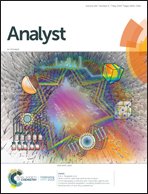Short-chain lipid-conjugated pH sensors for imaging of transporter activities in reconstituted systems and living cells†
Abstract
The design of ion sensors has gained importance for the study of ion dynamics in cells, with fluorescent proton nanosensors attracting particular interest because of their applicability in monitoring pH gradients in biological microcompartments and reconstituted membrane systems. In this work, we describe the improved synthesis, photophysical properties and applications of pH sensors based on amine-reactive pHrodo esters and short-chain lipid derivatives of phosphoethanolamine. The major features of these novel probes include strong fluorescence under acidic conditions, efficient partitioning into membranes, and extractability by back exchange to albumin. These features allow for the selective labeling of the inner liposomal leaflet in reconstituted membrane systems for studying proton pumping activities in a quantitative fashion, as demonstrated by assaying the activity of a plant plasma membrane H+-ATPase. Furthermore, the short-chain lipid-conjugated pH sensors enable the monitoring of pH changes from neutral to acidic conditions in the endocytic pathway of living cells. Collectively, our results demonstrate the applicability of short-chain lipid-conjugated sensors for in vivo and in vitro studies and thus pave the way for the design of lipid-conjugated sensors selective to other biologically relevant ions, e.g. calcium and sodium.



 Please wait while we load your content...
Please wait while we load your content...